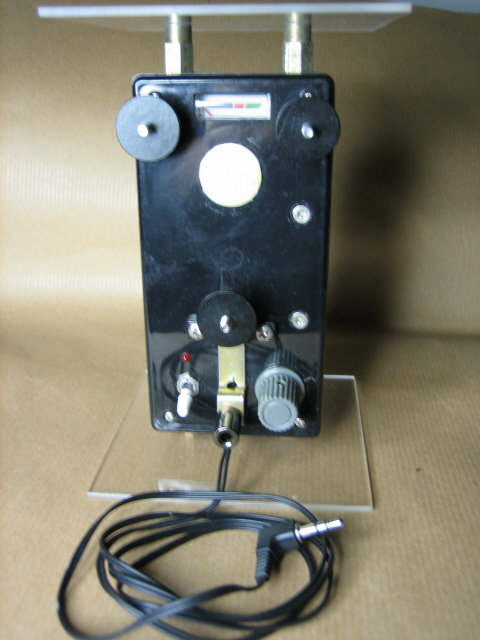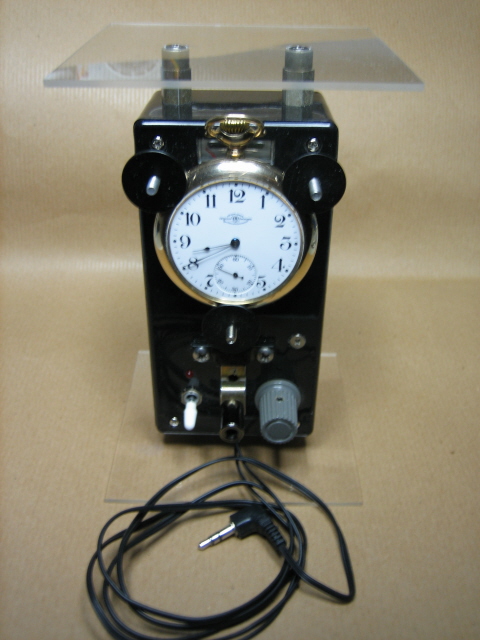
| WWT Shows | CLICK TO: Join and Support Internet Horology Club 185™ | IHC185™ Forums |

|
• Check Out Our... • • TWO Book Offer! • |
Welcome Aboard IHC185™  Internet Horology Club 185
Internet Horology Club 185  IHC185™ Discussion Site Main Page
IHC185™ Discussion Site Main Page  Horological Discussions, Questions and Answers
Horological Discussions, Questions and Answers  Pocket Watch Discussions
Pocket Watch Discussions  Timing machine sounds
Timing machine sounds
 Internet Horology Club 185
Internet Horology Club 185  IHC185™ Discussion Site Main Page
IHC185™ Discussion Site Main Page  Horological Discussions, Questions and Answers
Horological Discussions, Questions and Answers  Pocket Watch Discussions
Pocket Watch Discussions  Timing machine sounds
Timing machine soundsGo  | New Topic  | Find-Or-Search  | Notify  | Tools  | Reply to Post  |  |
Hello! Now i want explain how check accuracy of your pocket watch without dedicated time machine. You need good microphone or little amplifier with piezoelectric connected to your input microphone Pc sound card. I use commercial software CoolEdit pro, but is possibile use freeware Audacity software, work good too. This is my little amplifier:  Put PW on surface of piezoelectric  Open Cooledit pro and click RECORD, select sample 96000 and mono, 16 Bit  Record about 12 seconds and press STOP, you can see Wave generated.  Zoom wave, and you can see like it:  Go left to 0000000 of time line and cut FIRST wave where the wave is BIG (perfect cut). See Photo..  After cutting you can see that:  Go to right timeline, to the exact 10.000 seconds recorded.  When the accuracy is near perfect you see the timeline at 10.000 seconds where the wave is BIG ( yellow line). If the 10.000 seconds line is in other positions (front or rear), you can read lenght of error to the yellow line. ( Front= is Slow Rear= is Fast).  My lenght error is 0,007 x 8640= 60,48 sec for day (24 hours)  I hope someone can understand | |||
|
This probably isn't as complicated as it sounds,but I'll stick to my stopwatch. | ||||
|
Mario Interesting post for me Could you please show the backside of your amplifier and give a parts list ? A little plan would also be helpful. Regards Gerald | ||||
|
| IHC Life Member |
Very ingenious! I love when people figure out how to make neat stuff. Thank You for showing and yes, please post details of parts and assembly list if you don't mind. Roger | |||
|
Hi Fabrizio, interesting indeed, tnks...are that the sounds of impacts of the anchor on the banking pins? rgds Enzo | ||||
|
This is my working project with components:  | ||||
|
It's possible use a simply amplfier with only one transistor ( BC 182) , work good with pocket watch, not perfect with wristwatch.  | ||||
|
yes.. see diagram:  | ||||
|
Thank you Fabrizio Regards Gerald | ||||
|
Hi and thanks, then if you have 42 trains of pulses as displayied in 12,2 seconds isnt the error 0,09 seconds each alternance? rgds Enzo | ||||
|
Fabrizio, very nice post! Thank you very much! | ||||
|
Fabrizio, I have a doubt Where did you get this error value - 0,007 - and what is this number - 8640 ? Thanks in advance regards Lourival | ||||
|
Understood! tks | ||||
|
Ok! For more accuracy you can record one minut: Error lenght x 1440 = And.. You can know A/h ( Train Speed ) I count pulse in 10 seconds, my pw. South Bend do 50 pulse in 10 seconds. Calculating A/h = 50 x 6 x 60 = 18000 My South Bend work 18000 A/hours Is possible calculate Amplitude too | ||||
|
Hello Fabrizio and everybody, I see that I'n not the only one who decided to go the "homemade way" when he was confronted with the price of commercial watch timing machines (this was my reason,anyway). I made this one quite a long time ago and it gave me good service. The box containing the amplifier is mounted between two plastic squares, this allows it to be positioned in all the watch testing positions. The watch is clamped on top of the microphone (the yellow disk) between the three mushroom shaped adjustable holders, one of which slides and is spring loaded for quick mounting. The meter on top gives me the condition of the battery and the gray knob on the bottom adjusts the sensitivity. As software I use the "biburo watchmaster" that I find quite adequate for my needs. I had to calibrate it to compensate for the computer audio card clock error which would have caused an +8 seconds a day deviation if ignored (this is my case, every computer is different). Regards Peter  | ||||
|
With watch under test.  | ||||
|
Face up  | ||||
|
COOL Peter Drago !! Very good work! My circuits work good with all free software, how biburo and others, is perfect with Watch Escapement Analyzer commercial software. But i prefer look diagrams with audio software, i can understand problems with hairspring, escapement and other problems, how doctors check human heart. Many thanks | ||||
|
Thank you Fabrizio, 30 years in aerospace engineering has got to help! The reason I like the biburo (probably you can do the same with your software, I didn't try it) is that you can immediately see your beat error, both graphically and numerically, so that's the first adjustement to make, if required. Then you can graphically see the timekeeping performance vs. time (for 15 minutes cycles), I found this feature very handy to ferret out cyclic problems, like dirty or defective gears, rubbing hands etc. My box also has a low impedance output so I can plug in a pair of headphones and listen to the beat with my finely tuned ears (yeah, right!) I tell you on thing...I was sleeping much better before I started to check my watches performance with this system. I was surprised to find out that my finely adjusted @ pendant-up watch was actually a dog in other positions! Regards Peter | ||||
|
Hello Peter Drago, i not understand if only one tested watch work bad in other position or all watches you tested. Fabry | ||||
|
Hello Fabrizio, no,no, mine was just a general statement. Before having a timing machine, I was happy if any of my watches run the full lenght of the mainspring and kept good time in the "pendant up" position. When I started using the machine and I checked my watches timekeeping in all positions I found out that some of them were very bad in positions other than "pendant up". Me being a perfectionist, that required all sort of rework: balance poising, jewels replacement, hairspring adjustment, just to name a few. And even after this I was unable to get some of them where I wanted, I had to give up and accept a compromise in performance. That's what I meant. Regards Peter | ||||
|
Very interesting, I use a similar technique in CoolEdit myself. My variation on the technique is to record the sound as a stereo file, then replace one channel with a 2.5Hz square wave using the 'Generate Tones' feature. (after trimming the beginning of the file). That gives you reference lines that you can use to see where the correct time for the amplitude peaks should be. The advantage to doing this is that you can incorporate a correction for your computer sound card's clock crystal, by varying the frequency of the square wave you generate. Using a quartz watch, I calculated that for my sound card, I need to use a 2.50008Hz square wave for reference. | ||||
|
Very very good TIPS!! Thank you very much! Fabrizio | ||||
|
| Powered by Social Strata |
| Your request is being processed... |
|
©2002-2023 Internet Horology Club 185™ - Lindell V. Riddle President - All Rights Reserved Worldwide

